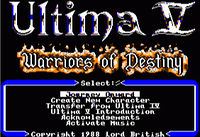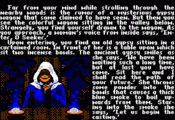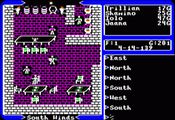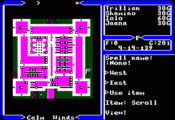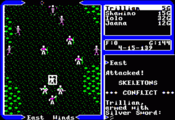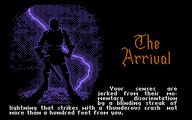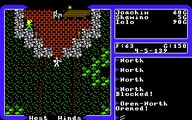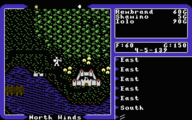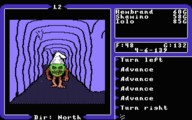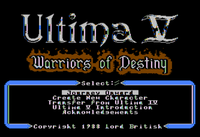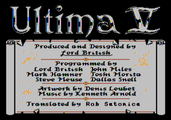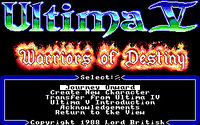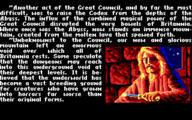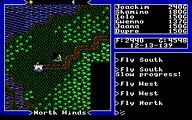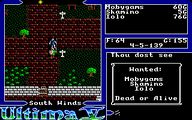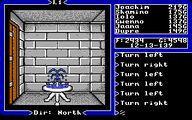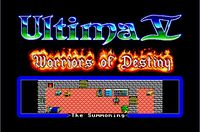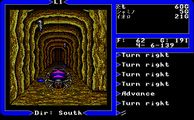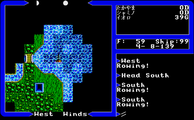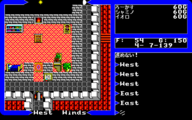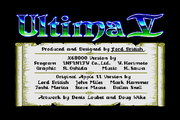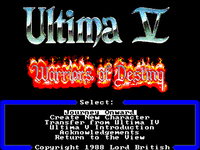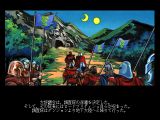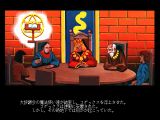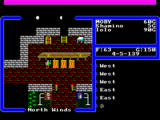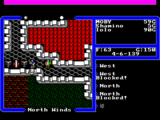Computer ports of Ultima V
Ultima V was the last game of the series to be originally developed on the Apple II. Like Ultima IV, the growing technology of computers created several ports that technically looked and sounded quite different, despite having the same game content. Note that this does not cover the NES-port of Ultima V, which is a separate article because of widespread changes done to the game content-wise.
The 8-Bit-Ports[edit]
The Apple II-Series Original[edit]
Ultima V was initially written to run on all 8-bit Apple II series (II, II+, IIe, IIc, IIc+) computers; the 16-bit Apple IIGS ran it using its transparent built-in //e emulation mode. The game came on four double-sided 5.25" floppy disks: Program & Dungeons, Britannia & Underworld, Townes & Dwellings, Castles & Keeps. The Britannia disk was used for the savegame; the bootup Program disk was the only one that could not be read and copied by standard disk-copying software for unprotected disks.
The game made full use of the Apple II's 280×196 high-resolution mode, which had six colors: orange, blue, magenta, green, black and white. As with other Apple II software, Ultima V made use of blue and orange being offset from the other colors by a half-pixel to smooth the edges of images and fonts. This was augmented by the slightly fuzzy images produced by the NTSC-based signals and composite monitors, an effect not seen on most Apple II emulators or screenshots.
As with other platforms, a wide range of sound effects was included; a number of short situational melodies were available as well. A full musical score was available for an Apple IIe with 128kb of RAM or Apple IIGS equipped with one of several popular sound and MIDI cards, such as Sweet Micro Systems' Mockingboard, Applied Engineering's Phasor, or Passport Designs' MIDI interface. With the Passport Designs card, one could play the music through the same MIDI instruments used as by professional musicians; the end-results varied but could be quite impressive with the right setup. Examples of the soundtrack played with different hardware: Phasor and dual Mockingboards. Unfortunately, the built-in music chip of the Apple IIGS is not supported. The amount of disk access is also reduced on systems with 128kb or more of RAM, since some code is cached in the extra memory that has to be frequently reloaded from on 64kb systems.
This game pushed the aging Apple II architecture to its limits, however, and therefore it can be slow in certain situations. To offset this, the game supported hardware accelerators for the Apple, offering a command to enable and disable acceleration from within the game. Also, unlike all previous parts, this game will not automatically pass a turn when the player waits too long without giving a command; this means that players with an accelerator can think as long and as carefully as players without one.
Apple II – Combat against skeletons
The C64/128-Port[edit]
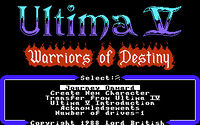
The port for the C64/C128 was created by Dr. Cat.
First off, compared to the Apple II, the graphics are clearly improved. They are now much more colorful and the color also is at the right spots (such as red paved roads). For a resolution of 320x200, they managed to get out the maximum. The low resolution however means, that indoor peer maps are never completely on the screen. Also, while the dungeon graphics are even better than the Apple II ones, they are still only one color. Also, this color is mostly off, since the cave dungeons are all blue, while brown would have been more fitting. The introduction remains in bad graphics.
While the port features a full musical score (though with only three voices compared to the eight of the Apple II version), the C64 simply does not have enough available RAM to play it. To access the music, the game must be played on a C128 computer running in native C128 mode (not in C64 emulation mode as almost all other games, including the other Ultimas), and started by having the disk in the drive when the computer is turned on, or by the BOOT command, not by the usual LOAD and RUN sequence typical of C64 games. Running on the C128 has the additional benefit of reducing the frequency of disk accesses, as some code that has to be re-loaded from disk all the time on the C64 can be cached in the extra memory.
There also were technical problems with the fastloader. Thanks to sloppy programming, it only works on an NTSC C64, not a PAL one, which neglected the European market. The game can be played on a European C64 by telling it at the start screen that you do not have a Commodore floppy drive but a third-party drive, but then, loading times will be lengthened, which, combined with very frequent and big loads, makes them highly annoying. On a C128, the fastloder code is not used at all, but this is less of a problem as this computer, in its native mode, loads noticeably faster than the C64 even without extra acceleration, provided a 1570 or 1571 floppy drive (as opposed to a 1541) is used.
One last thing of interest: the C64-port was released on 4 double-sided 5.25" floppy disks. Thankfully Origin had been wise enough to partition them into logical chunks to keep disk-swapping at a minimum. The sides are:
- Game (loading, menu and saved games)
- Dungeon (everything in the dungeons)
- Britannia (the overworld)
- Underworld (as the name says)
- Towne (cities and villages)
- Dwelling (huts. Also contains the introduction and endgame)
- Castle (big castles like Castle Britannia)
- Keep (small fortresses like Bordermarch)
Ultima V Gameplay Video (Commodore) (YouTube)
In 2021, a fan-optimized version of the port was released, called Ultima V Remastered.
C64 – Iolo's hut
C64 – Gremlin in a dungeon
The Atari 8-bit-Port[edit]
The Atari 8-bit-port of Ultima V was started but seemingly never finished.
Disk 1 and 2 have been found, however the "Britannia" disk has not, essentially making this port up to now unplayable. Richard Garriott, in a 1988 online conference with The Gamers' Forum on CompuServe, informed the Atari community that the 8-bit-port had been contracted out for development. To date, image captures of the title and credits screens are the only tangible pieces of evidence of this port that have been uncovered. Rob Satonica, of Creative Software Systems, is credited for the code translation.
The 16-Bit-Ports[edit]
The IBM PC-, Amiga- and Atari ST-Ports[edit]
The ports for the 16-bit machines done for the Amiga, Atari ST and the IBM PC are far more advanced than the previous two. Graphically they all look exactly the same: 16 color graphics in a 320x200 resolution. The Amiga and Atari always have an "Ultima V" logo on the screen for whatever reason.
The Amiga and Atari ST-ports have mouse support, something that the PC-port lacks (a mouse still was only optional for a PC in 1988).
Probably due to the fact that the port of Ultima IV for the Amiga got released in the same year as Ultima V, this port has no option for a character transfer, something the Atari ST and IBM PC versions offer. It is somewhat of a regretful omission, since the next game in the series again offers the option to transfer a character on those systems.
The Amiga version is rather buggy, especially with the way the keyboard is read. Too often, keypresses will either not be read at all, or will bounce and (for example) a single keystroke will be interpreted as three. The Atari ST version in turn also suffers from a bad bug. In this case, the game is prone to crash by first suddenly asking for a different disk and then hanging, thus forcing a complete reset. This normally meant the loss of considerable game progress since the last save. These bugs have never been patched.
Furthermore, on the Amiga it was not possible to copy one of the disks to have multiple characters at the same time. If one wanted to create a new character the old one was overwritten by the new one. Since the PC version could be installed onto a hard disk, it circumvented this problem and also allowed character transfers.
The biggest difference is how music is handled:
- The Atari ST-port has full music. However, the pieces are played in places that do not correspond with the C128 or Apple II version. For example, "Villager Tarantella" is played in all eight Cities of Virtue in the C128/Apple II versions, but the Atari ST version instead plays "Greyson's Tale" in all but New Magincia.
- On the Amiga, only one song (unique to this version of the game) is playing the entire time, despite the Amiga clearly being able to shoulder all of the music. It is unknown why this decision was made. Also, few minor sound effects begin playing if music is turned off. Mainly when moving around and some combat effects.
- The IBM PC-port originally had no music at all, since AdLib music cards only came on the market a little after Ultima V's release. The Ultima V Upgrade Patch re-inserts all the music from other versions.
The IBM PC-port consists of four 5.25" floppies, and it is supposed to be installed on the hard disk. The Atari-port has three 3.5" floppies and the Amiga two 3.5". The Amiga version cannot be installed to a hard drive and the computer must be booted from the floppies in order to play the game.
The Japanese Ports[edit]
The Sharp X68000- and PC-98-Ports[edit]
The Sharp X68000 version of Ultima V by PonyCanyon contains completely redrawn tile graphics that take advantage of the Sharp X68000's superior graphic abilities. This is especially noticeable inside the dungeons. All graphics without exception are high resolution, thus making this the best-looking port of the game. A trade-off is, that the tile sprites have very little to no animation. Note that while the resolution is 768x512, only 640x480 are used. This version also includes the complete music track available in other versions. This version is only available in Japanese however.
Note that the port for the PC-98 is identical to this one, down to the last pixel. However, the Japanese text looks different and, unlike the Sharp-port, on the PC-98 the sprites are fully animated. Due to the resolution of the PC-98 being 640x480 it does stand to reason that it is the platform the game was originally developed for and a cut-back version was then ported to the X86000.
Sharp X68000 – Lord British's room
The FM Towns-Port[edit]
The FM Towns version of Ultima V, made by Fujitsu, plays identical to other versions of Ultima V, but takes advantage of the CD-ROM capabilities of the FM Towns machine to include high-colour graphics in the introduction, even though they still are only upscaled 320x240 apart from the text. The tile graphics appears to be based on the other 16-Bits versions but seems to have a smaller color palette which makes them look slightly inferior. Like with the previous game, a pink bar displays messages related to data reading and writing at the top of the screen. The music is used in a way that is different from both the Apple II/C128 version and the Atari ST version; for instance "Greyson's Tale" will play into the cities of Virtue like in the Atari ST version, but "Stones" will play while camping just like in the Apple II/C128 version.
This port came with a special full-colour poster not found in other versions. Additionally, as the other versions of the games on the FM Towns up to this one, the game does sport a special introduction not seen in any other port of the game. CD-quality renditions of the Ultima Theme and Greyson's Tale are used for the title screen and the special introduction respectively.
FM Towns – In Britain
See Also[edit]
External Links[edit]
- Ultima V Gameplay Video (Commodore) (YouTube)
- Apple II – Ultima V Midi Music (YouTube) – Ultima V gameplay
- Ultima V – FM Towns Story (YouTube) – introduction
| Computer Ports | |
|---|---|
| Games | Ultima I ☥ Ultima II ☥ Ultima III ☥ Ultima IV ☥ Ultima V ☥ Ultima VI ☥ Savage Empire |
